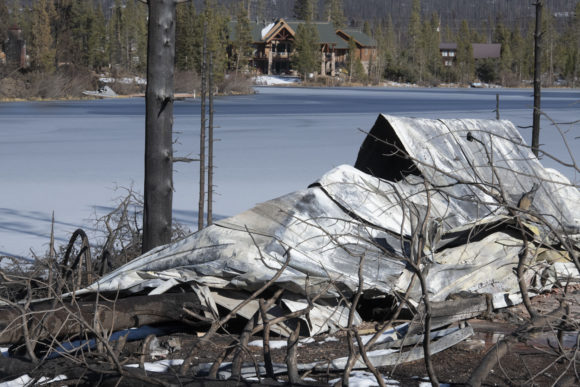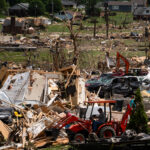DENVER (AP) — Grand Lake Fire Marshal Dan Mayer never thought the East Troublesome Fire would make it to town.
On the morning of Oct. 21, 2020, the fire was still about 20 miles (32 kilometers) away from the vacation spot on the western edge of Rocky Mountain National Park. The perimeter had crept east at a predictable pace for days. In the worst case, Mayer imagined it would lose momentum against Lake Granby, a large reservoir in the area.
Then the winds picked up.
“You had your expectations,” he said. “Then, when you saw it coming, it got scary.”
Mayer would soon witness a blow-up, a moment when a fire expands with dangerous force and ferocity. His sense of surprise wasn’t unique, either. The rapid growth of the East Troublesome Fire shocked firefighters and scientists, redefining how quickly Colorado wildfires can grow in an era of rapid climate change.
Only now are scientists beginning to understand the forces behind the firestorm. Their insights could help inform a new set of tools to prevent and predict the most severe wildfires, but their overall assessment is bleak.
As Colorado warms and dries, expect more events like the East Troublesome.
“Fires don’t grow that fast”
The fire started to shift about a week after first being reported north of Kremmling. As wind gusts hit 60 miles per hour, the mushroom cloud above laid out across the county, smothering Grand Lake in a blanket of thick smoke.
The change was critical. Embers rocketed ahead of the fire line, a behavior known as spotting. Mayer saw it play out himself around 8:50 p.m. After hearing radio reports of the blaze working its way up Highway 34 toward Grand Lake, he saw “what looked like a small meteor” land in a field on the western edge of town.
Within about half a minute, Mayer said the fire lit treetops and started to run toward Columbine Lakes, a subdivision west of town. He issued an urgent warning to firefighters.
“We need to get everybody out of Columbine! They’re gonna get flanked from this fire burning in!”
The blaze sprinted through parts of the neighborhood, narrowly missing Grand Lake itself. As the evening wore on, it would jump the Continental Divide in Rocky Mountain National Park despite the lack of fuels above the tree line.
When the sun rose on Oct. 22, hundreds of structures had burned and one couple was dead after refusing to evacuate. The fire would incinerate 193,812 acres according to the U.S. Forest Service, making it the second-largest in Colorado history. For Mayer, the most remarkable statistic is how quickly the fire grew. In less than a day, the East Troublesome burned more than 120,000 acres, making it by far the most rapid-fire expansion in state history.
“If anyone would have asked me if it was possible for this fire to grow more than a hundred thousand acres in one day, I would have laughed. Fires don’t grow that fast.”
In Mayer’s mind, Grand Lake only narrowly avoided a calamity on the scale of the 2018 Camp Fire, which killed 85 in and around Paradise, California. The winds pushed the East Troublesome just past the Grand Lake, not through it. He also thinks the smoke served as a sort of early warning system, prompting residents to leave before authorities issued official evacuation orders.
The speed meant residents and firefighters had almost no margin to react.
“The way that thing came through _ you couldn’t have stopped it,” he said.
“All the factors…are increasing”
Mayer isn’t the only person playing back Colorado’s 2020 extreme fire events. In the aftermath of the East Troublesome, Chad Hoffman, an associate professor of wildland fire science at Colorado State University, assembled a team to study the causes behind the state’s big blow-ups.
“The idea is that can help us predict when they’re going to occur and maybe even help us figure out ways to deal with them moving forward,” Hoffman said.
While the team is just getting started, it’s already clear fast fires are a big reason more acres are burning across the state. The team used satellite imagery from 2002 to 2020 to build a database of fires in the Southern Rockies. The region includes all of Colorado’s mountains along with parts of Utah, Wyoming and New Mexico.
The results show the fastest-growing fires are also the most destructive. According to the database, 10 percent of all fires which grew the fastest accounted for more than half the total acreage burned.
The basic forces behind blow-ups aren’t a mystery. For a fire to get big fast, it needs lots of fuel, lots of oxygen and lots of dry weather.
All of those ingredients were abundant before the East Troublesome Fire.
Colorado’s ongoing drought had dried out fuels in the already overgrown forests in Grand County. At the same time, warm temperatures stretched into October, a month when many people in Grand County usually take their first ski runs. The high-wind event on Oct. 21 added the final element. Each of those factors has only become more common and extreme in an era of rapid climate change.
“Not only is it getting drier and hotter, but it’s possibly getting windier, which means all the factors that we believe are influencing fire behavior are increasing,” Hoffman said.
It’s less clear whether Grand County’s pine beetle infestations fed the firestorm. Over the last few decades, the rice-sized insects have left entire mountainsides draped in dead, red-needle trees. The stands look ready to burn, but one study found fire activity in Colorado hasn’t increased in response to the dieoffs.
Jonathan Coop, a professor in forest ecology at Western Colorado University and another member of Hoffman’s team, said that doesn’t mean beetle kill wasn’t a factor in the East Troublesome Fire or other blow-ups. It just means scientists haven’t nailed down a connection.
“To what extent the beetle outbreak influenced either the fire spread rates or intensity is still an open-ended question, where the science kind of needs to keep up,” said Coop.
“The skies started turning dark”
Another open question is the role of plumes above big blow-ups.
On the afternoon of Oct. 21, Hopper Becker, a volunteer fire captain with the Grand Fire Protection District, remembered a remarkable change in the cloud above the East Troublesome Fire. The blaze had started burning with enough intensity to create a pyrocumulus cloud, where intense heat lofts moisture into the upper atmosphere to condense into thunderheads.
From his day job at the county sanitation plant, Becker said the cloud looked like a “big fluffy pile of lemon meringue.” But as he drove home from work, he said it started to press down to the ground and run with darker colors. When he got home, he climbed onto his roof with a pair of binoculars.
“The skies started turning dark. It was like someone took a grease pen and was just smearing it right above the contour of the earth,” he said. “It almost looked like an impressionist painting.”
Brad White, the chief of the Grand Fire Protection District, said he had never seen similar fire behavior, but later thought it could have been what experts call a “column collapse.” The events occur when a plume above a fire falls under its own weight and cool air, supercharging the flames with a rush of fresh oxygen.
“It just really fit the bill,” White said.
Hoffman, the CSU fire scientist, later examined the early data around the East Troublesome. He said high winds, unconnected to the fire itself, appear to be the main factor behind the fire’s rapid expansion. At the same time, he said it’s possible strange plume behavior drove the fire at particular moments.
“What that means for fire behavior is a little tricky,” he explained. “We know the formation of those clouds are generally associated with extreme stuff, but they can both promote and hinder fire spread, depending on other factors.”
Either way, those dynamics make it harder for firefighters to predict wildfires. Almost all computer models used in the field only account for how weather affects fire, not how fire can affect weather. A new round of more advanced computer forecasting tools, known as “coupled models,” is currently used in laboratories.
Through his upcoming research, Hoffman hopes his team can identify when advanced models could be more helpful to firefighters.
_ “We live in burnable landscapes”
Even if fire scientists learn to predict when blow-ups are likely, they won’t be easy to prevent.
Camile Steven-Rumann, a Colorado State University fire ecologist and another member of Hoffman’s team, said society needs to shift how it understands the problems presented by fires. Rather than trying to stop it, she said the goal should be to encourage less severe blazes.
“You could have a lot of areas burned, but if all of that is burning at a low severity, you don’t see a lot of the forest change,” she said. “We have a greater potential for tree survival _ and those landscapes we love continuing to be there.”
The shift won’t be easy. Stevens-Rumann said authorities would need to conduct far more prescribed burns, which could reduce fuels ahead of a big blow-up. In particular, she said it’d be wise to simply let natural fires burn if they don’t present an immediate danger to human life or the environment.
“We live in burnable landscapes,” said Stevens-Rumann. “And they’re only getting more burnable.”
The East Troublesome Fire has reinforced a similar conclusion for Fire Chief Brad White. It showed him there’s often not much a fire department can do when presented with a truly ferocious expansion. Looking out on Elk Mountain, where the fire grew before sprinting toward Grand Lake, he pointed to all the land still primed to ignite.
“We probably need to be looking at prescribed burns that are in the thousands of acres,” he said. “Those kinds of efforts are going to be what keeps the bulk of our communities safe.”
About the photo: Rubble from a home in the Sun Valley subdivision near Grand Lake, Colorado is across a lake from a home that was spared. The East Troublesome Fire was substantially slowed down last week after quickly becoming one of the largest wildfires in Colorado history overnight. Sunday, Nov. 1, 2020. ( Jerilee Bennett/The Gazette via AP)
Was this article valuable?
Here are more articles you may enjoy.


 Trump Administration Targets Resiliency Funds to Shrink FEMA’s Role
Trump Administration Targets Resiliency Funds to Shrink FEMA’s Role  Cars Are Getting Smarter. Why It Matters for Claims Professionals
Cars Are Getting Smarter. Why It Matters for Claims Professionals  Four Ex-VW Managers Convicted in Germany Over Diesel Scandal
Four Ex-VW Managers Convicted in Germany Over Diesel Scandal  Delivery Hero Hit by $376 Million Fine for Glovo Cartel
Delivery Hero Hit by $376 Million Fine for Glovo Cartel 